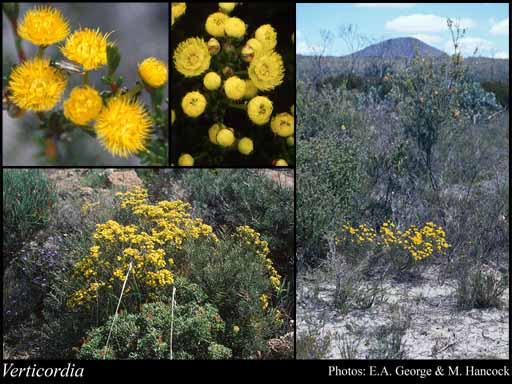- Reference
- Prodr. 3:208 (1828)
- Name Status
- Current

Scientific Description
Common name. Featherflowers. Family Myrtaceae.
Excludes V. verticordina (F. Muell.) A.S. George (N.G. Marchant pers. comm.).
Habit and leaf form. Shrubs, or trees (rarely); evergreen; bearing essential oils. Plants with neither basal nor terminal concentrations of leaves; to 2(–7) m high. Leptocaul. Helophytic to xerophytic. Heterophyllous, or not heterophyllous. Leaves minute to medium-sized; opposite (or scattered), or whorled (in V. verticillata); decussate; 3 per whorl, or 4 per whorl; leathery; petiolate to sessile; gland-dotted; aromatic; edgewise to the stem, or with ‘normal’ orientation; simple; pulvinate, or epulvinate. Leaf blades dorsiventral, or isobilateral, or centric; entire; flat, or solid; terete, or semi-terete, or solid/angular; linear, or lanceolate, or oblong, or ovate; linear, or ovate, or obovate, or oblong, or elliptic, or orbicular; pinnately veined, or parallel-veined, or one-veined; cross-venulate, or without cross-venules. Mature leaf blades adaxially usually glabrous, or pubescent (when ciliate on the margins); abaxially usually glabrous, or pubescent (when ciliate on the margins). Leaves without stipules; without a persistent basal meristem. Leaf anatomy. Hairs present, or absent. Stem anatomy. Secondary thickening developing from a conventional cambial ring.
Reproductive type, pollination. Fertile flowers hermaphrodite. Unisexual flowers absent. Plants hermaphrodite. Entomophilous, or ornithophilous. Pollination mechanism conspicuously specialized, or unspecialized.
Inflorescence and flower features. Flowers solitary, or aggregated in ‘inflorescences’ (apparently); axillary; in racemes, or in spikes, or in corymbs. Inflorescences simple, or compound. The terminal inflorescence unit cymose. Inflorescences of 1(-3) flowers, with the great variation in the length of both the peduncle and flower-bearing part of the branchlet giving rise to the appearance of large inflorescences; pseudanthial, or not pseudanthial. Flowers (bi) bracteolate. Bracteoles persistent, or deciduous. Flowers small to medium-sized; fragrant, or malodorous, or odourless; regular, or somewhat irregular to very irregular (particularly in V. carinata); zygomorphic. The floral asymmetry (when noticeable) involving the perianth, or involving the perianth and involving the androecium. Flowers 5 merous; cyclic. Free hypanthium present (petals ‘inserted on the calyx’); turbinate (to hemispherical, occasionally vertically compressed); villous, silky, pubescent or glabrous, often ribbed, in some species bearing reflexed appendages. Perianth with distinct calyx and corolla; 10; 2 -whorled; isomerous. Calyx present; 5; 1 -whorled; gamosepalous; lobed. Calyx segments divided (each 5–15-lobed, the lobes plumose, fimbriate, erose or divaricately divided). Calyx imbricate; more or less equalling the corolla (usually); regular; basally appendaged (many species with recurved or reflexed basal auricles or cilia while in most of sect. Pennuligera there are reflexed basal lobes), or neither appendaged nor spurred; green, or cream, or yellow, or red, or pink, or purple, or violet, or brown. Calyx lobes elliptic. Corolla present; 5; 1 -whorled; appendiculate (in sect. Pennuligera and V. rennieana each petal with 2 basal auricles), or not appendiculate; polypetalous; imbricate; regular, or unequal but not bilabiate (in V. carinata); hairy abaxially, or glabrous abaxially; plain, or with contrasting markings; white, or cream, or yellow, or orange, or red, or pink, or purple, or brown; persistent, or deciduous. Petals ovate, or obovate, or orbicular; clawed, or sessile. Corolla members fringed (or digitately divided, dentate or erose), or entire (rarely). Androecial members definite in number. Androecium 20. Androecial members branched. Androecial sequence determinable, or not determinable. Androecial members free of the perianth, or adnate (to the petals at the base forming a short tube in V. cunninghamii and V. verticillata); all equal, or markedly unequal (alternately short and long); free of one another, or coherent; when united, 1 - adelphous (connate into a ring or tube to varying extents); when ‘definite‘, 1 -whorled. Androecium including staminodes. Staminodes 10 (alternating with the stamens), or 15 (when only 5 fertile stamens present); non-petaloid (terete, compressed or flat, sometimes lobed or divided, often glandular-warted, hairy or fimbriate). Stamens 10, or 5 (in V. picta and V. rennieana); attached on the rim of the hypanthium, or attached above the hypanthium (when adnate to petals); remaining included; all more or less similar in shape; isomerous with the perianth, or diplostemonous; alternisepalous and oppositisepalous; both opposite and alternating with the corolla members; erect in bud, or inflexed in bud. Filaments glabrous, or hairy (rarely); filiform, or cylindrical, or strap-shaped. Anthers all alike; dorsifixed, or basifixed; non-versatile; dehiscing via pores, or dehiscing via short slits, or dehiscing via longitudinal slits; introrse; tetrasporangiate; appendaged (when connective produced above anther), or unappendaged. Gynoecium 2 carpelled. The pistil 1 celled. Gynoecium syncarpous; eu-syncarpous; inferior. Ovary unilocular; 1 locular. Epigynous disk present. Gynoecium stylate. Styles 1; apical, or lateral (centric or central); becoming exserted, or not becoming exserted; hairy (bearded), or hairless. Style hairs branched or simple. Stigmas 1; capitate (or small). Placentation basal (the placenta to one side (lateral-basal), and peltate in subgenus Eperephes). Ovules in the single cavity 1–13; funicled; ascending; collateral (or in one lateral row); non-arillate; anatropous.
Fruit and seed features. Fruit non-fleshy; indehiscent; a nut; 1 celled; 1(–2) seeded. Seeds non-endospermic. Cotyledons 2.
Geography, cytology, number of species. Native of Australia. Endemic to Australia. Australian states and territories: Western Australia and Northern Territory. Northern Botanical Province, Eremaean Botanical Province, and South-West Botanical Province. N=6,7,8,9,11,16 or 22.
Etymology. From the Latin verticordia; an epithet of Venus, the Turner of Hearts, to whom the myrtle was sacred; the plant is a myrtle and was so named on account of the beauty of the flowers.
Keys
A Key to Western Australian Species in the Chamelaucieae Tribe of Myrtaceae
B.L. Rye, M.D. Barrett, T.D. Macfarlane, N.S. Lander, M.E. Trudgen, N.G. Marchant, K.R. Thiele